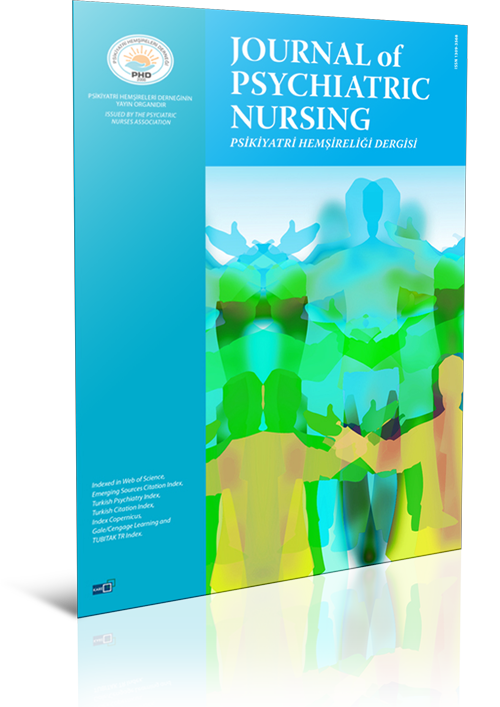
Volume: 12 Issue: 1 - 2021
| 1. | Frontmatter Pages I - III |
| EDITORIAL | |
| 2. | Editorial Leyla Küçük Page IV |
| RESEARCH ARTICLE | |
| 3. | Comparison of disability and social functionality levels and subjective recovery perceptions of the patients received and did not receive service from community mental health center* Selda Öztürk, Nihan Altan Sarıkaya, Sevcan Öz doi: 10.14744/phd.2020.08379 Pages 1 - 8 INTRODUCTION: This study was aimed to investigate the disability, social functioning and subjective recovery of patients who have been followed up and do not followed up in the Community Mental Health Center (CMHC). METHODS: This cross-sectional and descriptive research was conducted with patients who have been followed up in CMHC (n=19) and do not followed up in CMHC (n=19) in between dates of June-August 2018. Questionnaire form, Social Functioning Assessment Scale (SFAS) and Subjective Recovery Assessment Scale (SubRAS) were used for data collection. Data were analysed by the use of Independent-Samples t test, Chi-Square test and Spearman correlation Analysis. RESULTS: There was no statistical significance between the patients who followed up CMHC and do not followed up CMHC. It was determined that patients who followed up in CMHC had less disability, better functioning and subjective feeling of recovery. It was determined that as age of onset and income increased, the social functioning of the patients also increased (p=0.031, p=0.032, respectively). Significant negative correlation were found between SFAS and WHO-DAS-II (p=0.045) and positive correlation between SFAS and WHO-DAS-II total score (p=0.020). Significant negative correlations were found between WHO-DAS-II and SubRAS total score (p=0.002). DISCUSSION AND CONCLUSION: There was no significant difference between disability, social functioning and subjective feeling of recovery of patients who followed up in CMHC and do not followed up in CMHC. |
| 4. | Perceived care burden and related factors in primary caregivers of patients with bipolar disorder Begüm Çamlı, Sevil Yılmaz doi: 10.14744/phd.2020.34654 Pages 9 - 17 INTRODUCTION: This study was carried out using a descriptive design to determine the perceived care burden of primary caregivers of bipolar patients and the related factors. METHODS: The sample of the study included caregivers of patients with bipolar disorder in the outpatient clinics and inpatient clinics of a university hospital in Istanbul. Data were collected between March and September 2018 using a personal information form and the Caregiver Burden Inventory. Mann Whitney U test, independent sample t test, Kruskal Wallis H test, one-way ANOVA, LSD, and Dunns tests, and Spearman and Pearson correlation analyses were used to analyze the data. RESULTS: Analysis of the data indicated that 60.4% of the caregivers were women and that the mean age of the caregivers was 38.36±11.69 years. The caregivers mean score on the Caregivers Burden Inventory was 41.99±19.9, with the highest mean score on the subscales being 12.35±5.25 on the Developmental Burden subscale. Caregivers who resided in the same home as the patient, were children of the patient, voluntarily provided care, experienced frequent difficulties in performing their role, evaluated their spiritual life as weak, had a patient often needed help from someone else in self-care and treatment, were subjected to violence by their patients, and had a patient with a high frequency of symptoms associated with bipolar disorder or comorbidities had statistically significantly higher total scores on the Caregivers Burden Inventory and on the Inventorys sub-scales than those of others (p<0.05). A statistically significant correlation was found between the number of days per week the caregivers provided care and the Time Dependence Burden subscale (p<0.001). DISCUSSION AND CONCLUSION: Caregivers of the patients with bipolar disorder had a nearly moderate level of burden. It is recommended that additional comparative studies involving larger samples of caregivers from different socioeconomic backgrounds be conducted on the subject of care burden. |
| 5. | The relationship between social intelligence, self-esteem and resilience in healthcare professionals and the affecting factors Nurgül Özdemir, Vesile Adıgüzel doi: 10.14744/phd.2020.96658 Pages 18 - 28 INTRODUCTION: This study was carried out to determine the relationship between social intelligence, self-esteem and resilience in healthcare professionals and the affecting factors. METHODS: This is a cross-sectional and descriptive study. It was conducted at the Siirt Public Hospital between June 3 and September 15, 2017 with 241 healthcare professionals who agreed to participate in the study. The data were collected using a personal information form, the Rosenberg Self-Esteem Scale (RSES), the Tromso Social Intelligence Scale (TSIS) and the short version of the Resilience Scale (RS-14). The data were analyzed using SPSS Windows 22.0. RESULTS: The mean total scores obtained by the healthcare professionals were 74.2±11.4 on the TSIS, 21.2±4.18 on the RSES, and 19.5±5.0 on the RS-14. A positive statistically significant relationship was found between results on the Rosenberg Self-esteem Scale, the short version of the Resilience Scale, and the Tromso Social Intelligence scale and social intelligence subscales (p<0.001). Additionally, social intelligence was determined to be a factor predicting self-esteem and resilience. The self-esteem, social intelligence and resilience of the healthcare professionals who were good at self-expression were statistically significant and high (p<0.05). DISCUSSION AND CONCLUSION: The healthcare professionals had sufficient self-esteem and good levels of social intelligence and resilience, and self-esteem, resilience, and social intelligence were correlated. It can be suggested from these results that higher self-esteem, social intelligence and resilience levels in healthcare professionals would help them cope with stress and burnout. |
| 6. | The effects of ambivalent sexism on nursing students menstrual attitudes Menekşe Nazlı Aker, Funda Özdemir, Fatma Özlem Öztürk doi: 10.14744/phd.2021.20981 Pages 29 - 34 INTRODUCTION: This study evaluates the effects of ambivalent sexism on nursing students menstrual attitudes. METHODS: This descriptive study was carried out with 289 nursing students during the 20172018 academic year. A questionnaire developed by the researchers about the students socio-demographic and menstruation characteristics, the Ambivalent Sexism Inventory (ASI) and the Menstrual Attitude Questionnaire (MAQ) were used as data collection tools. The data were evaluated using SPSS 14.0. The descriptive data are shown as numbers, percentages, means, and standard deviations. Pearsons correlation was used with the ASI and MAQ scores. The threshold for statistical significance was p<.05. RESULTS: The students mean age was 19.73±1.33 and 37.4% of them were in their first year of study. Their mean ASI score was 76.79±15.31, their mean hostile sexism subscale score was 40.97±9.87, and their mean benevolent sexism subscale score was 35.81±8.76. Their mean MAQ score was 86.86±10.31. There were no statistically significant correlations between their ASI scale and subscale scores, and their MAQ scores (p>.05). There was a relationship between their ASI score and some MAQ subscale scores (p<.05). DISCUSSION AND CONCLUSION: There were no significant relationships between ambivalent sexism and menstrual attitude. The factors that may affect menstrual attitudes should be investigated in order to improve and maintain students menstrual attitude. |
| 7. | Examination of student nurses' self-recognition and codependence Nazan Turan, Gülsüm Ancel, Şahinde Canbulat doi: 10.14744/phd.2020.53254 Pages 35 - 42 INTRODUCTION: Because the nursing profession demands the provision of services and continuous interaction with people uninterruptedly for 24 hours a day, self-recognıtıon is important for nurses. With the patient aiming to fulfil his/her needs for care and the nurse without adequate self-recognıtıon aiming to compensate her own emotional needs, both parts can reciprocally compromise on their own needs and become dependent on each other in the relationship. The aim of this study to examine the self-recognition of the nursing students and the conditions of co-dependence. METHODS: The research has been designed to be quantitative, cross-sectional and correlative. Sample of the research consists of 446 students attending nursery undergraduate program. Giessen Test (GT), Co-dependency Assessment Tool (CODAT) and a data collection form, which includes socio-demographic characteristics, have been applied to participants. Data analysis has been carried out with the SPSS 18.0 packet program. Mean, standard deviation, and the minimum and the maximum values were calculated for the quantitative variables. Pearsons correlation test was used for analyzing the independent variables. RESULTS: The study demonstrated that the fourth-grade students preferred to be controlled, socially potent, and submissive, and they had depressive personality characteristics. Regarding the co-dependency status of the nursing students, it was observed that the first-grade students tended to focus on the others, their self-worth was high, and they displayed a hiding self compared to the fourth-grade students. A positive correlation was found between self-awareness and co-dependency. Also, it was found that self-worth was positively correlated with the social potency-social impotency and hypomanic-depressive features (p<0.01). DISCUSSION AND CONCLUSION: Self-recognıtıon and co-dependency characteristics of student nurses were affected by self-worth, social potency/impotency, and hypomanic-depressive characteristics. İn order to prevent/correct co-dependence and to improve self-recognıtıon adequately in student nurses, education and training activities for supporting students' self-worth, self-recognition, affecting their mood and social potency favorably. |
| 8. | The psychological health of women with infertility: Hopelessness, anxiety and depression levels Songül Kamışlı, Candan Terzioğlu, Gürkan Bozdağ doi: 10.14744/phd.2020.48030 Pages 43 - 49 INTRODUCTION: This study was performed to determine the level of hopelessness, anxiety and depression in women who applied for infertility treatment. METHODS: The study was conducted with 70 female patients who applied to the IVF Unit of a university hospital in Ankara, Turkey between October and November 2019, had agreed to participate in the study and were diagnosed with infertility. The data of the study were collected using the face to face interview technique with the Beck Hopelessness Inventory (BHI), Beck Anxiety Inventory (BAI), Beck Depression Inventory (BDI) and Socio-demographic Information Forms. The ethical permission of the study was taken from the clinical research unit of the university where the research was conducted. Frequency and percentages in the evaluation of descriptive data; Chi-Square and Spearman Correlation Test was used for relationships and comparisons. RESULTS: Of the participants, 44.4% completed high school and 21.4% had an undergraduate degree. Of them, 60% were unemployed and 57.2% are middle-income earners. Of them, 41.4% were 33 and older; 55.7% stated that they had no children due to infertility. The average year of marriage was 7.4, average years of unprotected intercourse was 6.1, and BHI, BAI and BDI score averages were 7, 35 and 17 respectively. It was determined that there was a significant relationship between the status of unemployment of the women participating in the study and BHI, BAI and BDI scores, and between the years of unprotected intercourse and the BAI scores. It was observed that there was a negative correlation between women's education levels and the BAI and BDI scores, whereas there was a positive relationship between unemployed and BHI, BAI and BDI. DISCUSSION AND CONCLUSION: As the education levels of the women participating in the study decreased, BDI and BAI scores increased. It was observed that unemployed women had high scores on BHI, BAI and BDI, and anxiety scores increased as the years they had unprotected intercourse increased. According to these findings, among women receiving infertility treatment; those with a low education level, those who do not work and those with many years of having unprotected intercourse should be considered as a high risk group and screened for anxiety and depression. Nurses working in the field of infertility should improve their psychosocial counseling skills and consultancy skills should be used actively in the services provided in this field. |
| 9. | Delirium determination form for children: A delphi method study Engin Turan, Gülay Manav, Gülbeyaz Baran doi: 10.14744/phd.2020.36693 Pages 50 - 58 INTRODUCTION: This study aims to develop a form capable of identifying delirium in children. METHODS: To develop this form, the Delphi method was used in this study and involved the participation of specialists who have conducted scientific studies and health professionals who have previously worked in the field of pediatrics intensive care. A total of 47 items were selected from the responses given in the first stage, and these items were then prepared in the form of a five-point Likert-type questionnaire for the second stage and delivered to 46 people who participated in the first stage. The second stage was completed with 38 respondents. After the completion of the second stage, the items underwent statistical analysis and were delivered to the same 38 people. Central tendency measures, including percentage, mean, standard deviation, median, first quarter and third quarter, and range were used to evaluate the data. Median, First Quarter (Q1), Third Quarter (Q3) and Width (Q3-Q1) are the statistical measures used to identify compromised items in the analysis of data collected by the Delphi method. RESULTS: According to the results from the Delphi method, the participants agreed on 32 items for delirium determination in children. The most important diagnostic criteria for delirium in children was defined by the consensus derived from the Delphi method. DISCUSSION AND CONCLUSION: It was concluded that the delirium diagnosis form for children that was developed using the Delphi method may be suitable for nurses working in intensive care units. As this study was strictly qualitative in nature, it is recommended that the form this study developed based on the opinions of experts, be quantitatively analyzed to further confirm its suitability for the diagnosis of delirium, which is difficult for nurses to diagnose in pediatric patients hospitalized in intensive care units. |
| QUALITATIVE RESEARCH | |
| 10. | Stigmatization experiences of parents of individuals with schizophrenia: A qualitative study Figen Şengün İnan, Zekiye Çetinkaya Duman, Ayşe Sarı doi: 10.14744/phd.2020.25901 Pages 59 - 66 INTRODUCTION: The aim of this study was to investigate the stigmatization experiences of parents of individuals diagnosed with schizophrenia. METHODS: This is a descriptive qualitative study. The study sample consisted of 16 parents providing care to individuals with schizophrenia. The study data were collected via individual interviews and analyzed using content analysis. RESULTS: Stigmatization experience is a multidimensional phenomenon. The data obtained in the interviews were categorized in four themes: the dimensions of stigmatization, the effects of stigmatization on life, coping with stigmatization and recommendations for reducing stigmatization. DISCUSSION AND CONCLUSION: The parents were adversely affected by stigmatization both in their emotional and social lives, and they have difficulty coping. The parents emphasized that society should be informed about fighting stigmatization and be encouraged to empathize with people who suffer from stigmatization. It is important for health professionals to be aware about parents stigmatization experiences and their effects. |
| 11. | Being a nurse working in a psychiatric department: A qualitative study Buket Şimşek Arslan, Kadriye Buldukoğlu doi: 10.14744/phd.2020.00236 Pages 67 - 75 INTRODUCTION: This study was designed to investigate the thoughts and experiences of nurses working in a psychiatric department. METHODS: Qualitative research methods and case study techniques were used. Individual interviews were conducted with 10 nurses working in the psychiatric department of 3 public hospitals. A personal information form and a semi-structured interview guide were used as data collection tools. Descriptive analysis methods were used to report the findings. RESULTS: Of the study participants, 9/10 were women, 5/10 were aged 4150, and 6/10 had a university degree. The most prominent theme related to the meaning of being a nurse in a psychiatric department was "awareness of mental illness" (4/10). The most common factor cited that make it difficult to be a nurse in a psychiatric department was "institutional factors" (7/10), and factors facilitating their work were as "support from the department" (6/10) and "team dynamics" (6/10). A notable difference in psychiatric nursing compared with general nursing was the emphasis on "holistic care" (5/10). DISCUSSION AND CONCLUSION: There are many factors that make it difficult to be a psychiatric nurse. Improvements such as additional training will contribute to the field of psychiatric nursing and increase the quality of nursing care. |
| REVIEW | |
| 12. | Online child sexual abuse: Prevalence and characteristics of the victims and offenders Cennet Kara Özçalık, Rahime Atakoğlu doi: 10.14744/phd.2020.30643 Pages 76 - 81 Today, with the widespread use of the internet, online child sexual abuse, facilitated through the rise in malicious sites that offer perpetrators the opportunity to interact with children, has emerged. Online child sexual abuse involves the obtaining, displaying, collecting, and distributing of sexual content for the purpose of deriving sexual satisfaction from a child. Online child sexual abuse threatens community mental health in terms of the harm it can cause to the mental health of children and families. The relevant literature includes only a limited number of studies on online child sexual abuse, with most focusing on child pornography. In this review, a definition of online child sexual abuse and its characteristics, the prevalence of online sexual abuse, and the characteristics of online child sexual abuse victims and offenders are presented in the light of the current literature. In addition, the review also provides information on how pedophilic culture facilitates child sexual abuse and, on the strategies, criminals employ to avoid being caught. The increased amount of time spent online and the development of new strategies by criminals escalates the risk of children being exposed to sexual abuse online. Therefore, it is crucial that online child sexual abuse be detected and prevented to protect community mental health. This review aims to raise awareness in mental health professionals by presenting information on online child sexual abuse literature and to contribute valuable data to future studies on this subject. |
| EDUCATION | |
| 13. | An overview of patient rights advocacy in psychiatric nursing through the film 55 Steps (Eleanor and Colette) Münire Temel doi: 10.14744/phd.2020.59455 Pages 82 - 84 |


















